Two-bedroom shipping container homes are an innovative housing solution that utilizes repurposed shipping containers as the building blocks for constructing a home.
These homes are gaining popularity due to their cost-effectiveness, speed of construction, and flexibility in design. Typically made from either one 40-foot container or two 20-foot containers joined together, they offer a compact and eco-friendly living space that can be customized to the homeowner’s needs.
They are particularly attractive for those looking to downsizing their living space or seeking an alternative to traditional housing.
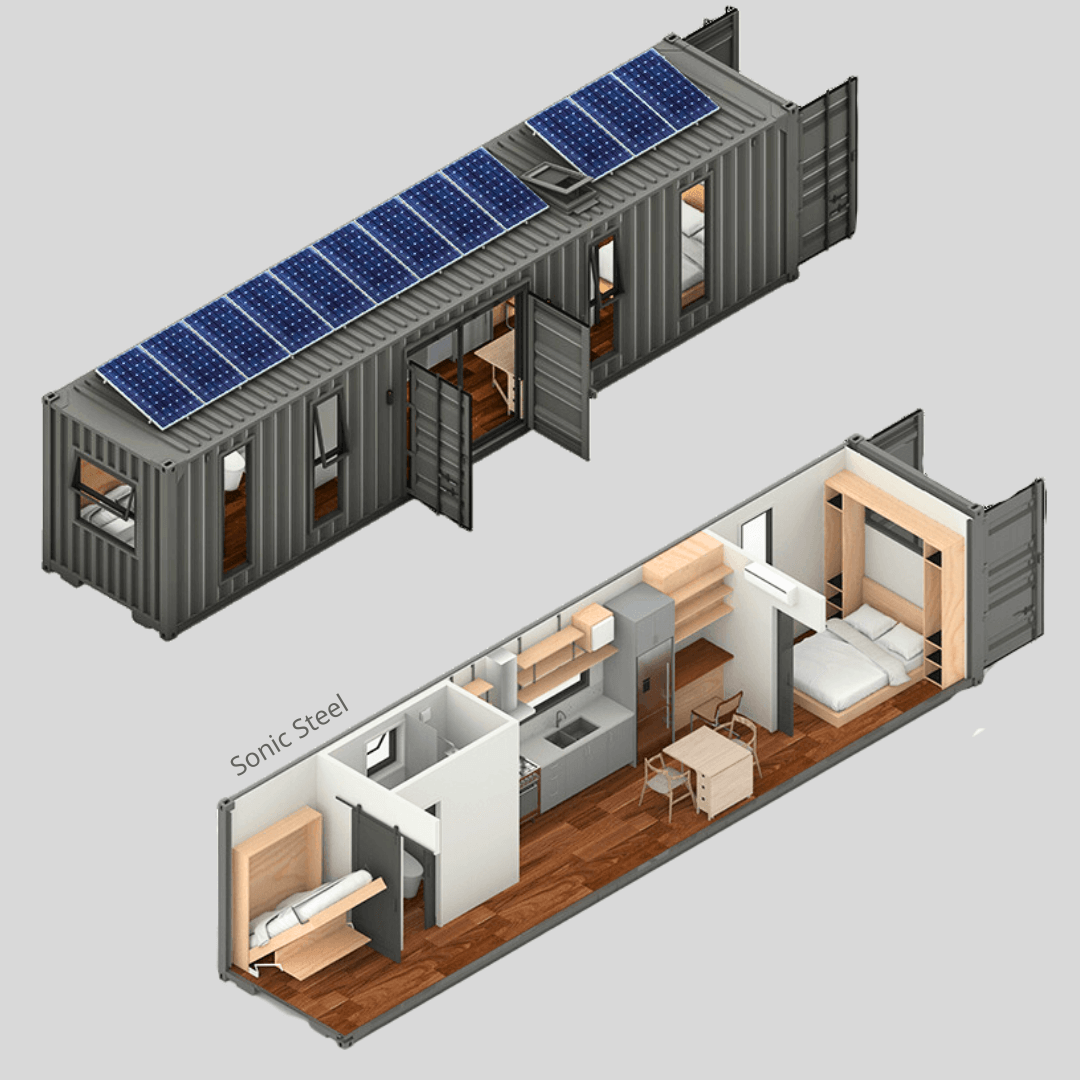
While some may question the practicality and comfort of living in a shipping container, these homes challenge preconceptions with stylish designs and modern amenities. Their interiors can be surprisingly spacious, and with the right layout, comfortably house a small family, making them a viable option for both permanent residences and vacation homes. Furthermore, the modular nature of container construction allows for expansive design possibilities, from minimalist one-floor layouts to more ambitious multi-level configurations. Their robust steel structure also contributes to the overall security and durability of the home.
Key Takeaways
- Shipping container homes provide an economical and sustainable housing option.
- Customizable designs offer a range of styles and layouts for various preferences.
- Two-bedroom container homes combine practical living with modern efficiency.
Benefits of Two Bedroom Shipping Container Homes
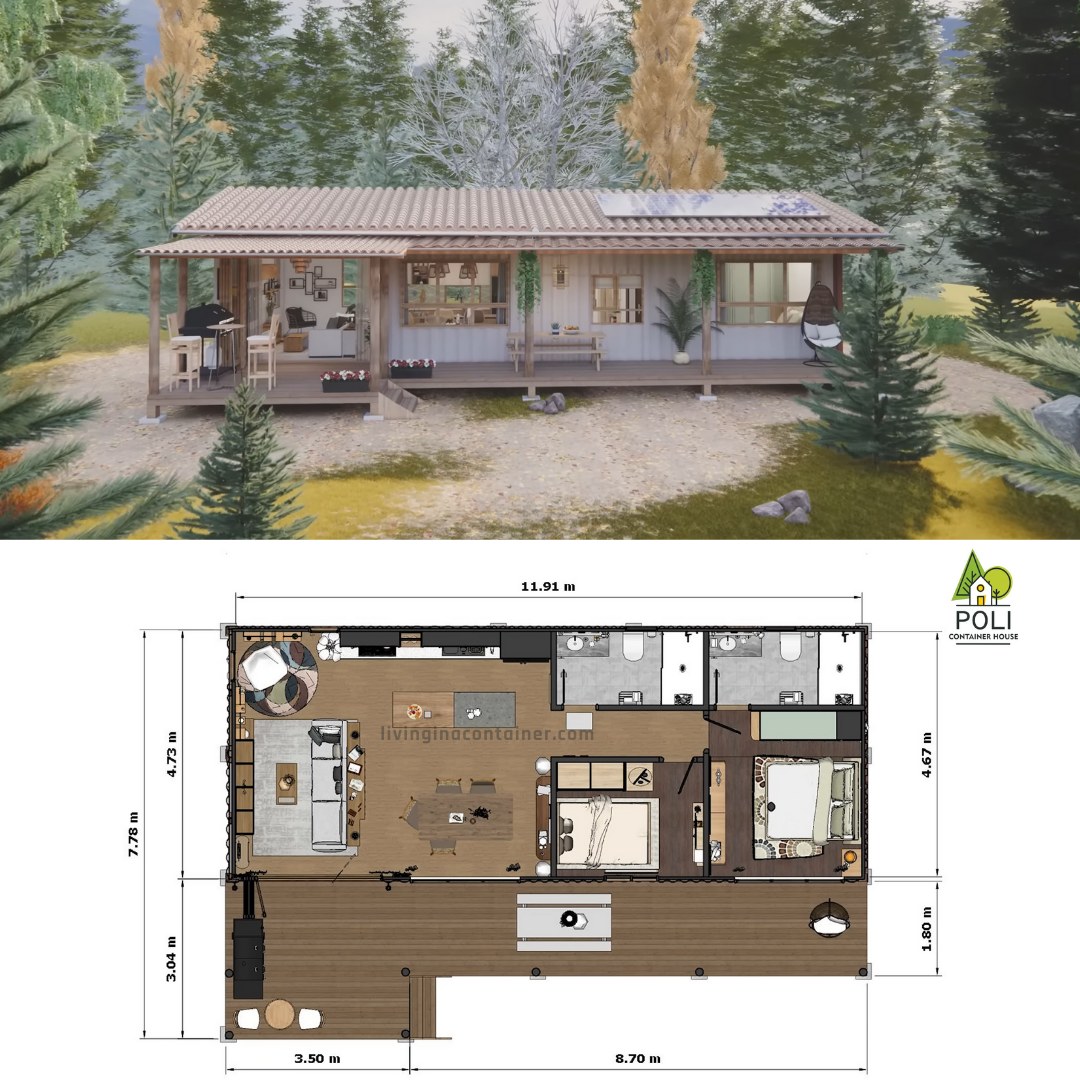
Two bedroom shipping container homes offer numerous benefits that cater to various lifestyle needs and preferences. Their eco-friendly nature stems from repurposing used shipping containers, reducing the demand for new construction materials. These homes contribute to a smaller carbon footprint, making them an attractive option for environmentally conscious individuals.
The cost-effectiveness of such homes is another notable advantage. Compared to traditional housing, shipping container homes can be more affordable due to the lower material costs and the potential for reduced labor expenses. Builders can fast-track construction since the primary structure is already in place, leading to further savings.
Layout efficiency is also a significant benefit. Clever design can maximize the usable living space within the compact dimensions of shipping containers. For instance, incorporating the kitchen and utility areas in the center of the home can provide a seamless flow between the living areas and private bedrooms.
Regarding durability, shipping containers are designed to withstand harsh weather conditions, which transfers into robust homes. Their steel structure provides a kind of resilience that traditional wood-framed homes might not offer.
| Advantages | Description |
|---|---|
| Eco-Friendly | Reuses materials, less environmental impact |
| Cost-Effective | Lower material and potential labor costs |
| Fast Construction | Pre-fabricated parts speed up building process |
| Space Efficiency | Innovative design maximizes limited space |
| Durability | Steel construction withstands extreme weather conditions |
In summary, two bedroom shipping container homes are a practical and sustainable option for modern living, balancing affordability with a touch of customization and durability.
Design and Style Options
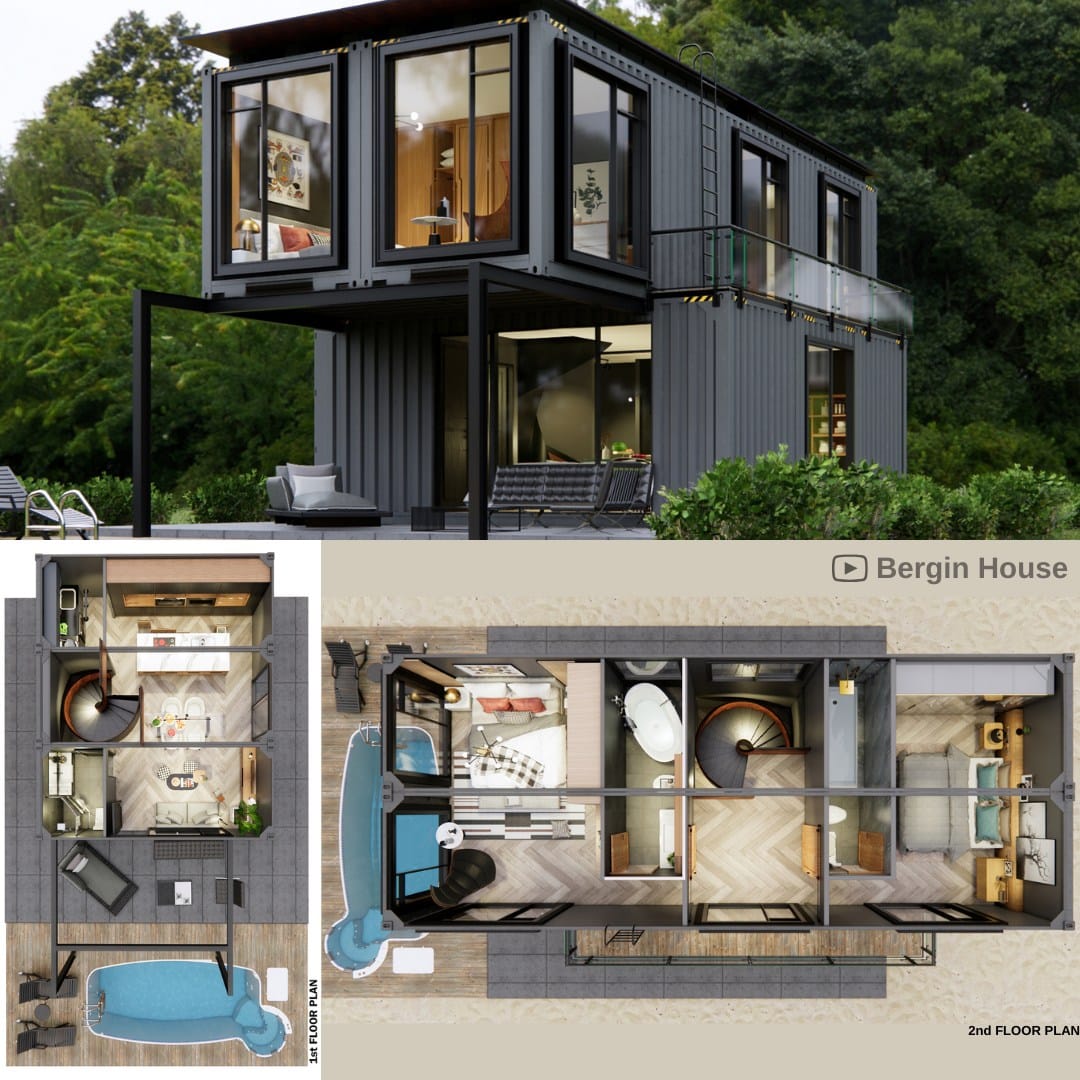
Two-bedroom shipping container homes offer a range of design and style options, allowing individuals to tailor their dream home to fit their needs. These homes typically utilize one or two 40-foot shipping containers, providing a substantial square footage that can be customized to include various living spaces.
- Minimalist and Modern: Many owners opt for a modern look with clean lines and a minimalist approach. Simple, yet highly functional features can include large glass windows and open-plan interiors.
- Rustic Charm: For those preferring a cozier aesthetic, the incorporation of wood finishes and a rustic design can create a warm and welcoming atmosphere.
- Industrial: The natural look of the shipping container allows for an industrial style, with exposed metal and a focus on durability and simplicity.
Outdoor space is a valuable addition to any home, and two-bedroom shipping container homes often come with options to include a patio or terrace, creating an inviting outdoor living area to relax or entertain.
The following list displays a variety of specific options based on actual designs:
- Two-Bedroom with Private Suites: Homes designed with each bedroom on opposite ends for privacy.
- Central Living Space: A common design includes a central living area flanked by bedrooms on either side.
- Maximized Efficiency: Use of built-in furniture and storage solutions to optimize available space.
These homes can be decked out with eco-friendly features such as solar panels and rainwater harvesting systems, which not only reduce the ecological footprint but also ensure cost-effective living. Whether one is seeking a compact abode or a more spacious residence, the versatility of shipping container homes provides ample opportunities for customization, giving every homeowner the potential to design their own unique space.
Technical Specifications and Considerations
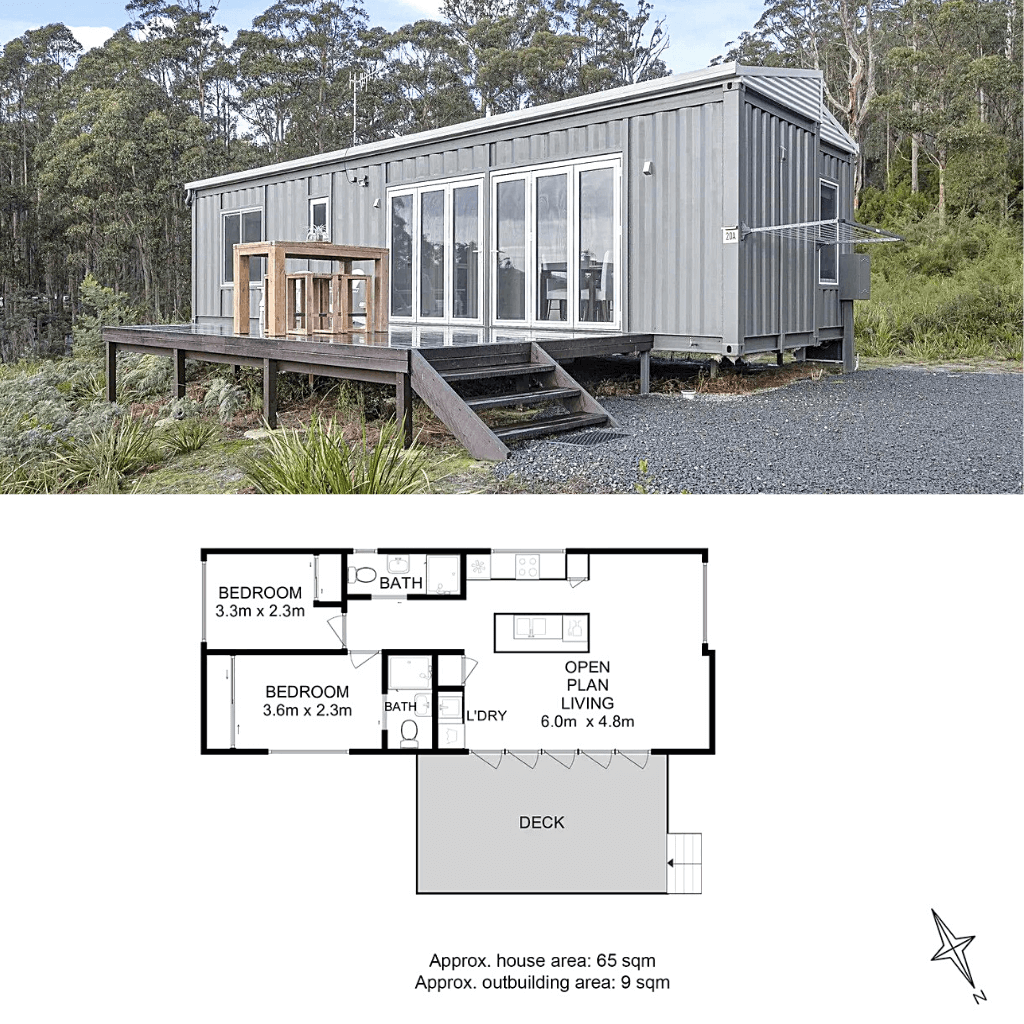
When designing a two-bedroom shipping container home, several technical specifications and considerations must be addressed to ensure functionality and comfort.
Dimensions and Layout:
Standard shipping containers typically come in two sizes: 20 feet by 8 feet or 40 feet by 8 feet. Two-bedroom homes often use two 40-foot containers placed side by side with modifications for a central hallway or living space. The final layout should maximize space utilization while considering the structural integrity of the containers.
| Standard Container Size | Dimensions |
|---|---|
| 20-foot container | 20′ x 8′ x 8.5′ |
| 40-foot container | 40′ x 8′ x 8.5′ |
Foundation:
A solid foundation is critical to the long-term stability of the home. Options range from simple concrete blocks to more complex poured concrete foundations, depending on the local soil conditions and climate.
Insulation:
Insulation is essential for maintaining a comfortable indoor climate. The choice of insulation material can vary based on climate, but it must avoid thermal bridges and condensation, which are common in metal structures.
Electrical and Plumbing:
Installation of outlets and plumbing needs careful planning, especially since shipping container walls are corrugated metal. Running conduits and pipes requires strategic placement and potential reinforcement of the container walls.
HVAC Systems:
Effective heating, ventilation, and air conditioning (HVAC) systems are necessary to combat extreme temperatures. The placement of HVAC units must be planned to ensure even distribution of air and to avoid compromising the container’s structure.
Climate Consideration:
For homes in regions with variable climate conditions, materials and construction methods must be chosen to ensure durability against corrosion, wind, and temperature fluctuations.
Remember to adhere to all local building codes and zoning regulations, as these will inform many of your design and construction decisions for a two-bedroom shipping container home.
RELATED
- Inspiring Two-Bedroom Container House
- Brand-New Two-Bedroom Container Home In Uvita
- 2 Containers, 245K YouTube Hits: Sustainable Home Design!
Floor Plans and Layouts
When adapting shipping containers into two-bedroom homes, floor plans play a crucial role in maximizing space utilization while ensuring comfort. Attention to detail in the design phase leads to a harmonious balance of privacy, functionality, and style.
Optimizing for Two Bedrooms
The challenge in designing a two-bedroom floor plan within the confines of a shipping container is ensuring each bedroom is adequately sized and offers sufficient privacy. Ideal floor plans position the bedrooms at opposite ends of the container or stack them in two-story configurations. For example, the Sea Eagle 68 uses a single-level approach sprawled across 732 square feet to accommodate two comfortable bedrooms.
Incorporating Living and Dining Areas
Incorporating living and dining areas into a container home’s floor plan calls for an open-plan concept to create a sense of spaciousness. Creative arrangements, such as an L-shaped layout, allow for clear division of the living space from the kitchen, while still maintaining the open feel typical of modern homes. This is demonstrated in designs like the 2 Story Shipping Container Home by Pin-Up Houses, which seamlessly blends the living room and kitchen on the lower level.
Including Multiple Bathrooms
Two bathrooms add convenience and value to any two-bedroom home, and shipping container layouts often aim to include at least one en-suite bathroom attached to a master bedroom. The additional bathroom can be placed adjacent to the second bedroom or in easy access to common areas to serve guests. A floor plan that exemplifies this is the Double Duo which smartly allocates space for both an en-suite and a separate full bathroom.
Customizing Your Container Home
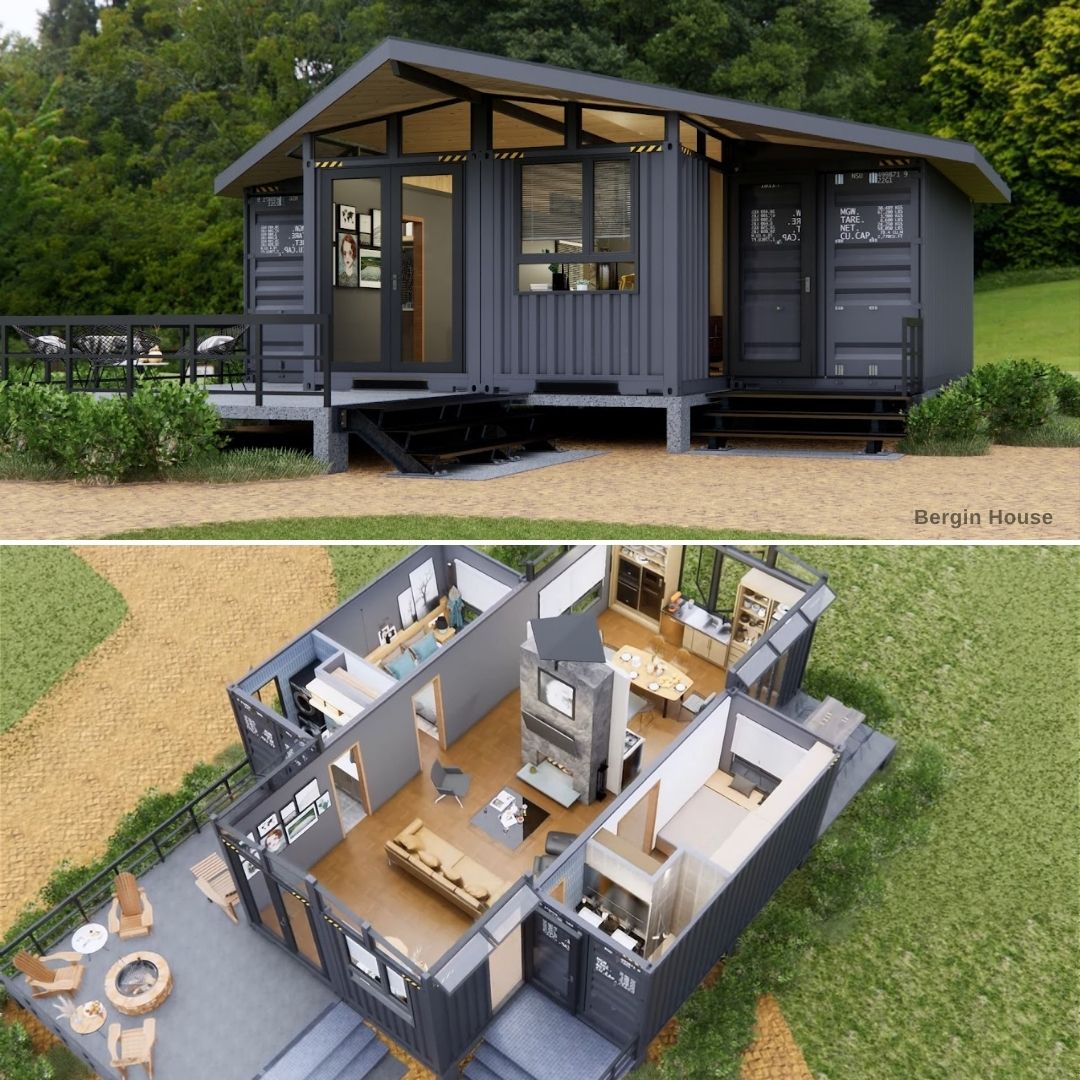
Optimizing a container home for comfort and functionality involves several key alterations and additions. Windows can be strategically placed to enhance natural light and airflow, creating a more spacious feeling. Options range from picture windows for unobstructed views to clerestory windows for privacy and light.
The selection of doors greatly influences the aesthetic and practical aspects. Sliding glass doors can merge indoor and outdoor spaces, whereas sturdy, insulated doors ensure energy efficiency and security.
Furniture selection demands consideration of space constraints. Multifunctional pieces like sofa beds or ottomans with storage are typically favored for a balance of comfort and utility.
When it comes to decor, owners can infuse personal style while maintaining a minimalist approach to avoid clutter. A harmonious color scheme and the strategic use of mirrors can make the interiors appear larger.
Custom container living also offers endless possibilities in internal layouts and finishes. Homeowners have the freedom to design bespoke living spaces that cater to individual needs and preferences, whether it’s creating an open-plan living area or adding built-in shelves for storage.
| Key Aspects to Customize | Considerations |
|---|---|
| Windows | Placement, Type, Energy Efficiency |
| Doors | Material, Style, Insulation |
| Furniture | Space-saving, Multi-purpose |
| Decor | Minimalism, Personal style, Color scheme |
| Custom Container Living | Layout, Built-in storage, Unique finishes |
Each decision in customizing a container home contributes to its overall comfort, functionality, and style. It’s crucial to carefully plan and choose features that reflect the owner’s lifestyle while ensuring the space remains practical and sustainable.
Practical Uses for Two Bedroom Container Homes
Two-bedroom shipping container homes are versatile and can adapt to various housing needs. They offer a unique combination of privacy and efficiency, making them suitable for different demographics and housing scenarios.
Ideal for the Empty Nester
For those who find themselves as empty nesters, downsizing to a shipping container home can be a practical decision. The compact nature and reduced maintenance requirements of a two-bedroom layout present an optimal solution for individuals seeking a smaller, more manageable living space that still affords an extra room for hobbies or occasional guests.
Adaptable as a Guest House or In-law Suite
A two-bedroom shipping container home can effortlessly transform into an inviting guest house or an in-law suite. It allows homeowners to provide a separate, self-contained living area for visiting family members or friends, ensuring comfort and privacy for both guests and hosts.
Leveraging as an Airbnb Rental
These homes can be an excellent opportunity for owners to enter the Airbnb rental market. A two-bedroom shipping container home can be styled as a unique and eco-friendly option for travelers, offering all the necessary amenities with the bonus of a distinct, memorable lodging experience.
Sustainability and Future Trends
Two-bedroom shipping container homes are at the forefront of a sustainable living movement that emphasizes efficiency and reduced environmental impact. These homes represent a growing trend in the housing sector that caters to modern needs while also being mindful of ecological concerns.
The Rise of Modular and Prefab Homes
Modular and prefab homes have seen a substantial increase in popularity due to their decreased construction waste and shorter build times. Shipping container homes exemplify this movement, with their inherent modular nature allowing for easy stacking and assembly. They provide a path towards sustainable living by making use of upcycled containers that might otherwise contribute to waste. Innovative designs have enabled the creation of sophisticated homes that are both functional and attractive.
Advancements in Environmentally Friendly Materials
Recent developments have introduced more environmentally friendly materials into the construction of shipping container homes. Insulation options, for instance, now include materials such as cotton fiber or sheep’s wool—to reduce energy consumption—which is both sustainable and effective. Paints and finishes with low volatile organic compounds have become the norm, contributing to the overall health of the environment and home occupants. These advances pair well with the recycling aspect of the homes, further cementing their role in the growing eco-friendly housing market.
RELATED
- From YouTube Inspiration to Reality: Martha’s $56,000 Container Home
- Shipping Container Home Cost: An In-Depth Analysis for Budget Planning
- 3 Bedroom Shipping Container Home Plans
Financial Considerations
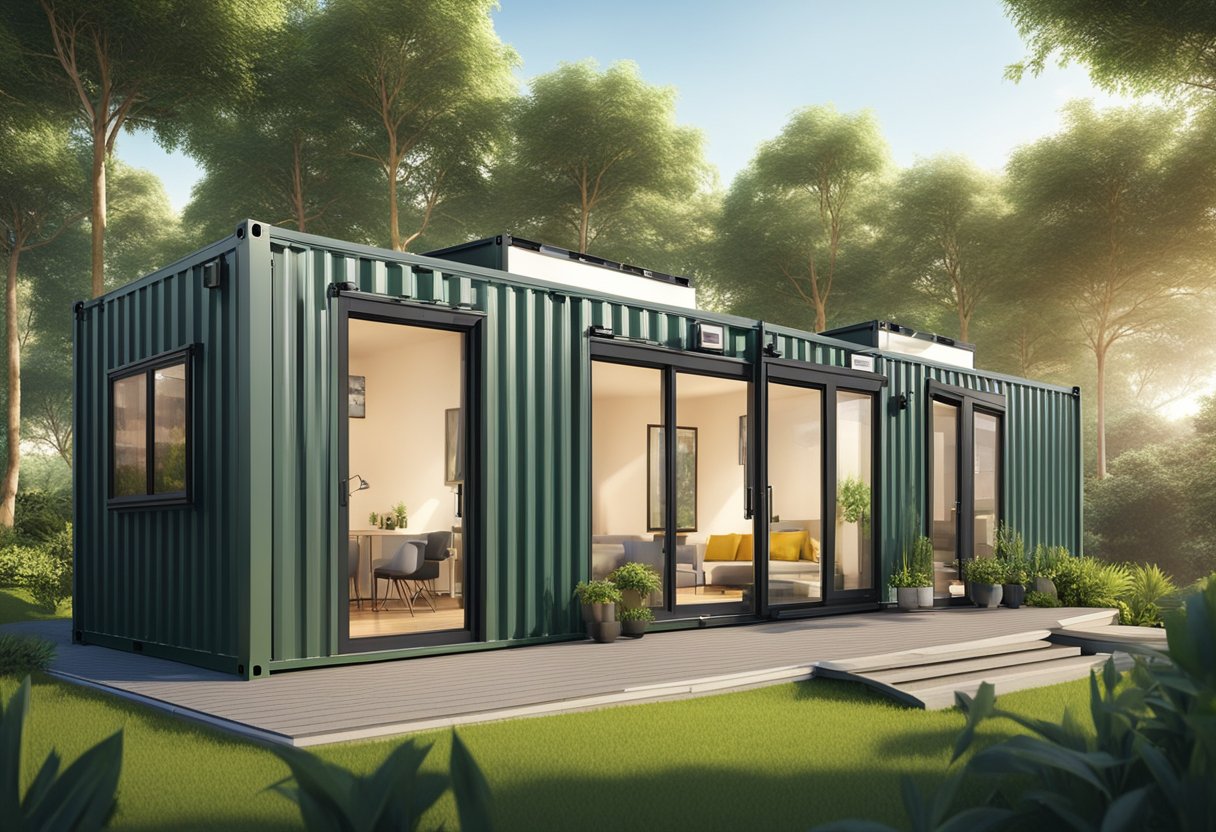
Creating a comfortable living space with a two-bedroom container home requires a clear understanding of the associated costs. Adequate budgeting is key to ensuring the financial feasibility of your project.
Understanding the Costs
Factors influencing the cost of two-bedroom container homes include the price of the containers themselves, site preparation, and the cost of materials and finishes. Prices can range from $25,000 to $250,000 on average depending on choices relating to design complexity, size, and the quality of materials. It is important to note that these homes require the same type of utilities and systems as traditional homes, which add to the overall price.
- Shipping Containers: $1,400 – $4,500 each
- Site Preparation: $1,500 – $5,000+
- Construction: $10,000 – $35,000+
- Utilities: $1,500 – $20,000+
- Finishes: $50 – $150+ per square foot
Budgeting for Your Container Home Project
Budgeting effectively requires a comprehensive breakdown of all potential expenses. One should account for the cost of purchasing the containers and the price of transporting them to your site. Do not overlook the cost of insulation, interior finishes, and exterior modifications which can significantly affect the total price. The following is a general budget outline for a two-bedroom container home:
- Containers: 60%
- Site Work & Foundations: 10%
- Interior Finishes & Fixtures: 20%
- Services & Utilities: 10%
Estimates based on industry standards should be validated with local contractors to assess regional cost variations. Additionally, homeowners should ensure they have a financial cushion for unforeseen expenses that can arise during construction.
Gallery of Two Bedroom Shipping Container Homes
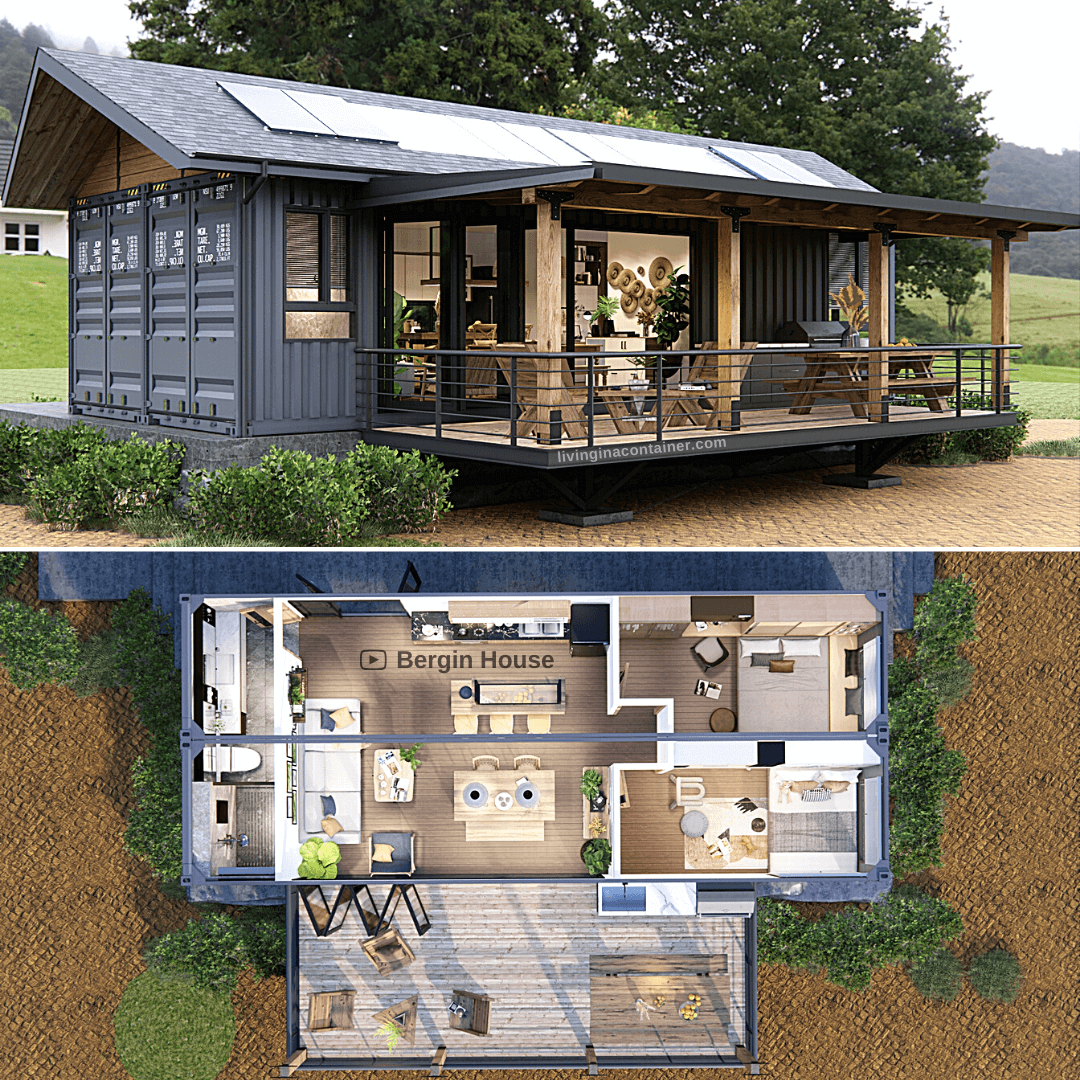
Exploring the realm of two-bedroom shipping container homes reveals a spectrum of architectural ingenuity and functionality. This gallery offers a glimpse into how these compact abodes can be fashioned to cater to the needs of small families or cozy living arrangements.
Showcasing Innovative Designs
In the innovative design of two-bedroom shipping container homes, architects leverage the modular aspect of shipping containers to create both aesthetically pleasing and practical living spaces. The Double Duo 2 Bedroom layout exemplifies such creativity, providing ample living space through the strategic placement and joining of containers. Adaptations of the X 40 C-Home design demonstrate the adaptability of container homes, effortlessly blending with various landscapes while ensuring that the structural integrity and comfort remain uncompromised.
Real-life Examples from Around the World
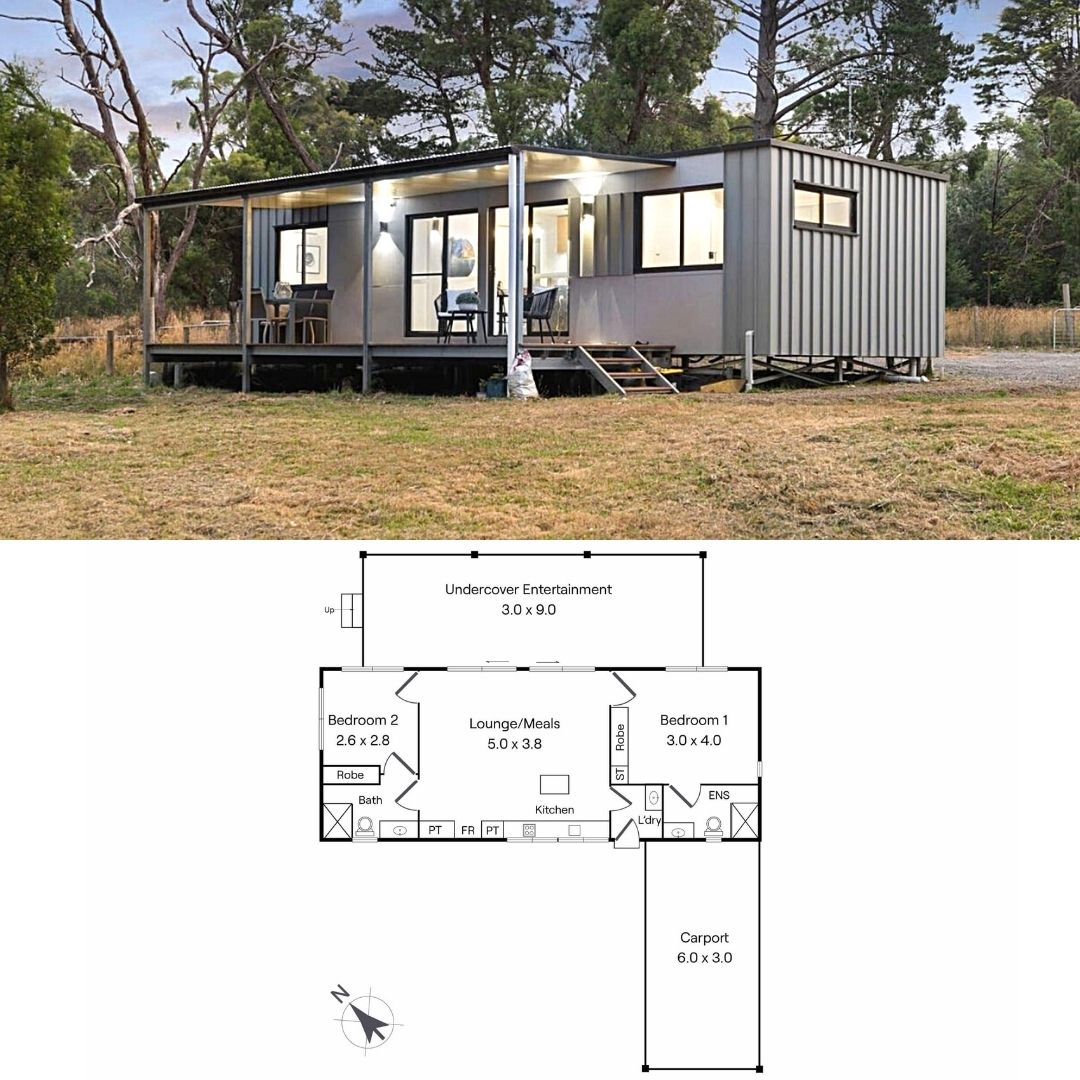
Globally, two-bedroom shipping container homes are emerging as a popular choice for sustainable living.
